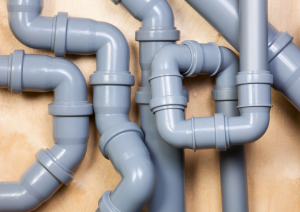How To Hide Plumbing Pipes Outside
Dealing with unsightly outdoor plumbing pipes can often feel like a daunting task for homeowners. While they play a crucial role in our home’s functionality, their presence can detract from the beauty of a well-maintained exterior. But fret not! With the expertise of R.S. Andrews plumbing fixture installation services, these essential fixtures can be artfully concealed or even integrated into your landscape design.
In this blog, we’ll explore how skilled plumbing professionals can provide seamless solutions, ensuring that your home’s aesthetics are preserved while maintaining optimal plumbing functionality.
Understanding Outdoor Plumbing Visibility
Outdoor plumbing plays a crucial role in the functionality of our homes, from water supply to waste disposal. However, these pipes and fixtures, often made of bright PVC or metallic materials, can stand out against the natural backdrop of gardens and patios. The visibility of these essential components can disrupt the aesthetic flow of an outdoor space, drawing unwanted attention to utility areas rather than more beautiful garden features.
It’s not just about beauty; exposed pipes can also be more susceptible to damage from the elements or accidental impacts. Addressing the visibility of outdoor plumbing is a balance between aesthetics and ensuring longevity.
1. Decorative Planter Boxes
Crafting your own planter box is a unique venture that offers both functionality and style. While selecting woods like cedar or redwood for their weather-resistant properties is essential, you might also consider integrating features like trellises for climbing plants, which can add vertical interest. Depending on the plants you intend to house, ensure the depth and width of the planter box are sufficient. Also, while painting and staining provide a chance to add flair, selecting a complementary shade that either contrasts or aligns with your outdoor palette can create a cohesive look. When thinking of drainage, layering the base with gravel before adding soil can promote better water flow, reducing the chances of root rot.
2. Faux Rock Covers
While the primary purpose of these rock covers is to conceal unsightly plumbing, their realistic appearance can add a touch of rugged natural beauty to garden spaces. Some homeowners choose to add smaller, genuine stones and pebbles around these faux rocks to enhance their integration into the landscape. When cleaning, a gentle scrub with soapy water can help retain their fresh appearance. Additionally, while their hollow nature is designed for covering purposes, ensure that there is adequate space for any heat or moisture to escape to prevent damage to the pipes.
3. Garden Art and Sculptures
The world of garden art is vast, and the possibilities are nearly limitless. From abstract metal structures to charming ceramic animals, there’s an art piece for every garden theme. When selecting sculptures, consider ones made of durable, weather-resistant materials to ensure they remain beautiful throughout the seasons. If you decide to paint or modify the pipes directly, using weather-resistant paints and finishes will guarantee longevity. Also, sculptures can be more than just decorative; bird baths or fountains can hide pipes while serving the local wildlife.
4. Bamboo or Reed Screens
Bamboo and reed screens not only offer a natural means of covering up plumbing but also introduce a Zen, tranquil aesthetic to gardens. While anchoring is vital for stability, consider weaving in fairy lights or planting flowering vines at the base to enhance their appeal. To extend the life of these natural screens, a light application of a weather-resistant sealant can protect them from rain and sun damage. Furthermore, setting up these screens in a semi-circular fashion or combining them with other elements like stones can make the concealment more natural and integrated.
5. Themed Play Areas for Kids
Incorporating exposed pipes into a child’s play area can provide a unique, interactive experience. For instance, by painting the pipes with fun, bright colours, you can turn them into an engaging element of the playground, like a telescope or a tunnel for small cars. Surrounding the pipes with soft mulch or rubber play mats can add a safety factor, ensuring children don’t get hurt while playing around them.
Why Concealing Outdoor Pipes Matters
Outdoor plumbing pipes, while essential, can be an eyesore in our gardens and yards. By hiding them, we maintain the beauty and harmony of our outdoor spaces. Concealed pipes also reduce the risk of them being accidentally damaged by outdoor activities or lawn equipment.
Furthermore, protecting pipes from direct exposure to harsh weather can increase their lifespan, preventing potential leaks and costly repairs. In essence, concealing outdoor pipes not only enhances the aesthetics of our exteriors but also serves a functional purpose, ensuring our plumbing systems remain efficient and intact for longer.
Frequently Asked Questions
Should plumbing pipes be inside or outside the wall?
Plumbing pipes are typically placed inside walls for aesthetic reasons and to protect them from external damage. However, some buildings or designs might have them outside for easier access or specific architectural styles. Always consult local building codes and professionals when deciding on placement.
Can you wrap your pipes?
Yes, you can wrap your pipes, especially in cold climates, to prevent freezing. Pipe insulation is commonly used for this purpose. It’s essential to ensure that the insulation material is appropriate for the type of plumbing pipes you have (e.g., copper, PVC, PEX). If you’re unsure or want to ensure proper insulation, consider consulting a professional plumber to assess your needs and install insulation correctly.
How can I make my outdoor pipes look better?
To improve the appearance of outdoor plumbing pipes, you can use decorative enclosures, faux rock covers, or vertical gardens. However, for a more comprehensive and aesthetically pleasing solution, it’s advisable to consult with a professional plumbing service that specialises in outdoor pipe concealment and can offer tailored recommendations.
What is the best material to cover pipes?
The best material to cover pipes depends on the specific application and location. For outdoor use, materials like decorative enclosures, faux rock covers, or vertical garden trellises can be effective. To determine the most suitable material for your pipes, it’s recommended to seek advice from a professional plumbing service with experience in outdoor plumbing concealment.
How do you make PVC pipe look good?
Making PVC pipes look good involves using techniques like painting them with appropriate outdoor-grade paint or incorporating them into a landscape design. A professional plumbing service can provide insights into enhancing the appearance of PVC pipes while ensuring they function correctly and meet plumbing standards. Consulting with experts is particularly valuable when dealing with PVC pipe aesthetics to avoid compromising their integrity.
Final Thoughts: Making Your Backyard Beautiful and Your Pipes Invisible
At R.S. Andrews, we know that your backyard should look good, and your pipes should work well. We’ve talked about how you can hide pipes outside in this blog. It’s like a game of hide and seek, but for pipes!
We’ve been doing this for many years. Our team makes sure that pipes fit well with your backyard and are hidden, but they still work perfectly. So, your yard looks nice, and there’s no trouble with the water.
If you’re unsure how to hide your outdoor pipes, just ask us at R.S. Andrews. We’re here to help make things look good and work right.






